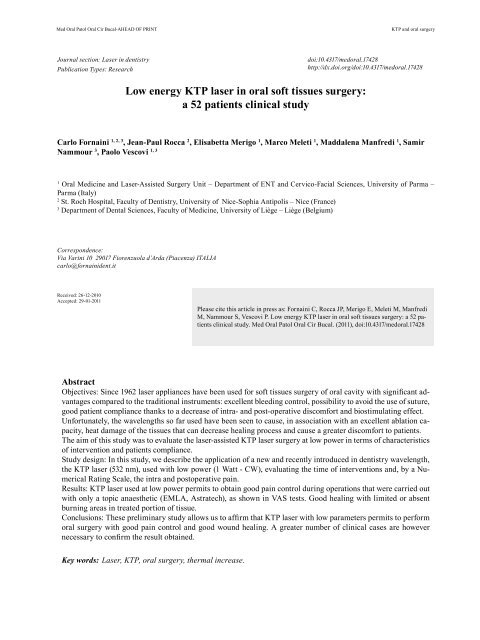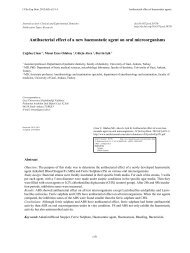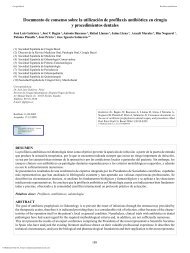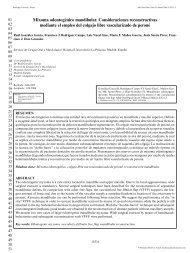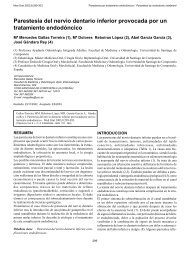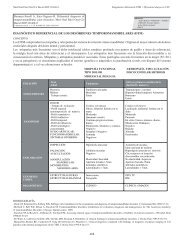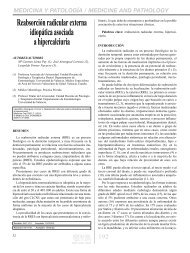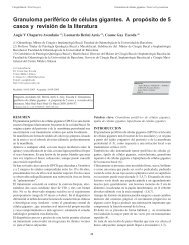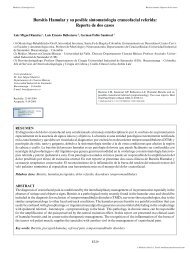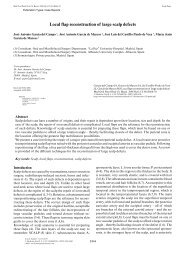Low energy KTP laser in oral soft tissues surgery ... - Medicinaoral.com
Low energy KTP laser in oral soft tissues surgery ... - Medicinaoral.com
Low energy KTP laser in oral soft tissues surgery ... - Medicinaoral.com
You also want an ePaper? Increase the reach of your titles
YUMPU automatically turns print PDFs into web optimized ePapers that Google loves.
Med Oral Patol Oral Cir Bucal-AHEAD OF PRINT <strong>KTP</strong> and <strong>oral</strong> <strong>surgery</strong><br />
Journal section: Laser <strong>in</strong> dentistry<br />
Publication Types: Research<br />
<strong>Low</strong> <strong>energy</strong> <strong>KTP</strong> <strong>laser</strong> <strong>in</strong> <strong>oral</strong> <strong>soft</strong> <strong>tissues</strong> <strong>surgery</strong>:<br />
a 52 patients cl<strong>in</strong>ical study<br />
Carlo Forna<strong>in</strong>i 1, 2, 3 , Jean-Paul Rocca 2 , Elisabetta Merigo 1 , Marco Meleti 1 , Maddalena Manfredi 1 , Samir<br />
Nammour 3 1, 3<br />
, Paolo Vescovi<br />
1 Oral Medic<strong>in</strong>e and Laser-Assisted Surgery Unit – Department of ENT and Cervico-Facial Sciences, University of Parma –<br />
Parma (Italy)<br />
2 St. Roch Hospital, Faculty of Dentistry, University of Nice-Sophia Antipolis – Nice (France)<br />
3 Department of Dental Sciences, Faculty of Medic<strong>in</strong>e, University of Liège – Liège (Belgium)<br />
Correspondence:<br />
Via Var<strong>in</strong>i 10 29017 Fiorenzuola d’Arda (Piacenza) ITALIA<br />
carlo@forna<strong>in</strong>ident.it<br />
Received: 26-12-2010<br />
Accepted: 29-01-2011<br />
Abstract<br />
Objectives: S<strong>in</strong>ce 1962 <strong>laser</strong> appliances have been used for <strong>soft</strong> <strong>tissues</strong> <strong>surgery</strong> of <strong>oral</strong> cavity with significant advantages<br />
<strong>com</strong>pared to the traditional <strong>in</strong>struments: excellent bleed<strong>in</strong>g control, possibility to avoid the use of suture,<br />
good patient <strong>com</strong>pliance thanks to a decrease of <strong>in</strong>tra- and post-operative dis<strong>com</strong>fort and biostimulat<strong>in</strong>g effect.<br />
Unfortunately, the wavelengths so far used have been seen to cause, <strong>in</strong> association with an excellent ablation capacity,<br />
heat damage of the <strong>tissues</strong> that can decrease heal<strong>in</strong>g process and cause a greater dis<strong>com</strong>fort to patients.<br />
The aim of this study was to evaluate the <strong>laser</strong>-assisted <strong>KTP</strong> <strong>laser</strong> <strong>surgery</strong> at low power <strong>in</strong> terms of characteristics<br />
of <strong>in</strong>tervention and patients <strong>com</strong>pliance.<br />
Study design: In this study, we describe the application of a new and recently <strong>in</strong>troduced <strong>in</strong> dentistry wavelength,<br />
the <strong>KTP</strong> <strong>laser</strong> (532 nm), used with low power (1 Watt - CW), evaluat<strong>in</strong>g the time of <strong>in</strong>terventions and, by a Numerical<br />
Rat<strong>in</strong>g Scale, the <strong>in</strong>tra and postoperative pa<strong>in</strong>.<br />
Results: <strong>KTP</strong> <strong>laser</strong> used at low power permits to obta<strong>in</strong> good pa<strong>in</strong> control dur<strong>in</strong>g operations that were carried out<br />
with only a topic anaesthetic (EMLA, Astratech), as shown <strong>in</strong> VAS tests. Good heal<strong>in</strong>g with limited or absent<br />
burn<strong>in</strong>g areas <strong>in</strong> treated portion of tissue.<br />
Conclusions: These prelim<strong>in</strong>ary study allows us to affirm that <strong>KTP</strong> <strong>laser</strong> with low parameters permits to perform<br />
<strong>oral</strong> <strong>surgery</strong> with good pa<strong>in</strong> control and good wound heal<strong>in</strong>g. A greater number of cl<strong>in</strong>ical cases are however<br />
necessary to confirm the result obta<strong>in</strong>ed.<br />
Key words: Laser, <strong>KTP</strong>, <strong>oral</strong> <strong>surgery</strong>, thermal <strong>in</strong>crease.<br />
doi:10.4317/med<strong>oral</strong>.17428<br />
http://dx.doi.org/doi:10.4317/med<strong>oral</strong>.17428<br />
Please cite this article <strong>in</strong> press as: Forna<strong>in</strong>i C, Rocca JP, Merigo E, Meleti M, Manfredi<br />
M, Nammour S, Vescovi P. <strong>Low</strong> <strong>energy</strong> <strong>KTP</strong> <strong>laser</strong> <strong>in</strong> <strong>oral</strong> <strong>soft</strong> <strong>tissues</strong> <strong>surgery</strong>: a 52 patients<br />
cl<strong>in</strong>ical study. Med Oral Patol Oral Cir Bucal. (2011), doi:10.4317/med<strong>oral</strong>.17428
Med Oral Patol Oral Cir Bucal-AHEAD OF PRINT <strong>KTP</strong> and <strong>oral</strong> <strong>surgery</strong><br />
Introduction<br />
Maiman built the first <strong>laser</strong> equipment <strong>in</strong> 1960 and after<br />
a short period of time, <strong>in</strong> 1962, this technology was<br />
used for the first time <strong>in</strong> dentistry by Goldman (1). A<br />
gradual expansion of <strong>laser</strong> use as well as the <strong>in</strong>troduction<br />
of newer, smaller and cheaper <strong>laser</strong> wavelengths<br />
and devices have been reported (2).<br />
Laser application has been shown to be of particular <strong>in</strong>terest<br />
<strong>in</strong> <strong>oral</strong> <strong>soft</strong> <strong>tissues</strong> <strong>surgery</strong> thanks to the <strong>in</strong>numerable<br />
advantages that it may offer, <strong>com</strong>pared to conventional<br />
<strong>in</strong>struments. The first wavelengths used <strong>in</strong> <strong>oral</strong><br />
<strong>surgery</strong> was Maiman’s Pulsed Ruby Laser. Argon Laser<br />
(488 nm), CO 2 (9600 nm), Nd:YAG (1064 nm) and Diode<br />
(810 and 980 nm) were subsequently used (3).<br />
Laser equipments may be easily used for surgical treatment<br />
of vascular lesions such as haemangioma and lymphangioma,<br />
thanks to the possibility to control bleed<strong>in</strong>g<br />
and avoid the use of suture. Moreover, patients affected<br />
by coagulation alterations as well as hypertension can<br />
be treated without specific pharmacological therapy<br />
(4).<br />
The effect of biostimulation associated with antibacterial<br />
activity improves the wound heal<strong>in</strong>g without <strong>com</strong>plications:<br />
thus the entire post-operative process may<br />
cause little dis<strong>com</strong>fort to the patient (5).<br />
Unfortunately the <strong>laser</strong> equipments available for dental<br />
<strong>surgery</strong> required high powers to obta<strong>in</strong> an ablative<br />
effect: this <strong>in</strong> order to achieve a photothermal type of<br />
<strong>in</strong>teraction with the target tissue. The side effect is heat<br />
damage of the treated <strong>tissues</strong>, caus<strong>in</strong>g an <strong>in</strong>creased dis<strong>com</strong>fort<br />
with both <strong>in</strong>tra- and post-operative pa<strong>in</strong>, delay<br />
<strong>in</strong> the heal<strong>in</strong>g process associated with oedema of the<br />
treated area, limit<strong>in</strong>g the use of this appliance.<br />
To avoid these <strong>com</strong>plications new technological devices<br />
have been <strong>in</strong>troduced, such as short shots <strong>in</strong>terspersed<br />
by rest periods to allow the tissue “thermal relaxation”<br />
(pulsed, superpulsed, chopped modes). In addition it<br />
has been reported that these new <strong>laser</strong>s may determ<strong>in</strong>e<br />
a decrease <strong>in</strong> sensitivity perception, less thermal tissue<br />
damage, even from the histological po<strong>in</strong>t of view (6).<br />
In this study we describe the use of a particular wavelength<br />
that, at the moment, is not very widespread <strong>in</strong><br />
dentistry: <strong>KTP</strong> <strong>laser</strong>, is a solid active medium <strong>laser</strong><br />
emitt<strong>in</strong>g <strong>in</strong> the visible portion of the spectrum (its beam<br />
is an <strong>in</strong>tense green light) produced by a special procedure.<br />
Firstly a Diode <strong>laser</strong> (810 nm) “pumps” <strong>energy</strong> to stimulate<br />
a crystal of Nd:YAG (1064 nm).<br />
Subsequently a crystal of Potassium-Titanil-Phosphate<br />
(KTiOPo 4 ) situated between the active medium and<br />
the semi reflective mirror <strong>in</strong> the Fabry-Perot chamber<br />
doubles the vibration frequency of the photons and so<br />
halv<strong>in</strong>g their wavelength and thus emitt<strong>in</strong>g the ray of<br />
532 nm (7).<br />
<strong>KTP</strong> <strong>laser</strong> has been <strong>in</strong>troduced <strong>in</strong> medical field thanks to<br />
its great aff<strong>in</strong>ity for haemoglob<strong>in</strong> and oxihaemoglob<strong>in</strong>,<br />
be<strong>com</strong><strong>in</strong>g very effective <strong>in</strong> vascular <strong>tissues</strong> (8). Moreover,<br />
<strong>in</strong> contrast to Nd:YAG <strong>laser</strong>, <strong>in</strong> the red <strong>oral</strong> <strong>tissues</strong><br />
it is absorbed at superficial tissue level avoid<strong>in</strong>g deep<br />
tissue penetration, determ<strong>in</strong><strong>in</strong>g a very safe <strong>laser</strong> (9).<br />
Even if the cost of this equipment is certa<strong>in</strong>ly greater<br />
than diode technology, the optic fiber delivery system,<br />
that is characterized by a small size, makes it an <strong>in</strong>strument<br />
of great <strong>in</strong>terest.<br />
One of the first uses of <strong>KTP</strong> <strong>in</strong> medical field was <strong>in</strong> Neuro<strong>surgery</strong><br />
operations (10). At the moment it is widely<br />
used <strong>in</strong> the vaporization of prostatic tumours (11-13) and<br />
<strong>in</strong> otolaryngological <strong>surgery</strong> of the larynx and epiglottis<br />
therapy of papillomatosis. tonsillectomies, naso-far<strong>in</strong>x<br />
tumours and ear-nose small bones operations (14-18).<br />
It has recently <strong>in</strong>troduced to the large <strong>in</strong>test<strong>in</strong>e <strong>surgery</strong><br />
(19).<br />
However <strong>KTP</strong> major use rema<strong>in</strong>s vascular <strong>surgery</strong> and<br />
treatment of superficial vascular <strong>surgery</strong> of the sk<strong>in</strong>,<br />
thanks to its aff<strong>in</strong>ity for haemoglob<strong>in</strong> (20, 21).<br />
In dentistry it was firstlyl used, with great success, <strong>in</strong><br />
teeth bleach<strong>in</strong>g, <strong>in</strong> association with a red hydrogen peroxide<br />
gel, <strong>com</strong>plementary colour of the green of this<br />
<strong>laser</strong> ray (22).<br />
Several studies have subsequently reported the efficaciousness<br />
<strong>in</strong> the decontam<strong>in</strong>ation of the root channels<br />
and periodontal pockets (23, 24).<br />
The purpose of our study is to propose the use of this<br />
wavelength <strong>in</strong> the <strong>surgery</strong> of <strong>oral</strong> <strong>soft</strong> <strong>tissues</strong> us<strong>in</strong>g low<br />
powers (1 Watt).<br />
Us<strong>in</strong>g these parameters, it has been possible to observe<br />
that the <strong>in</strong>strument gives an excellent ablative effect<br />
avoid<strong>in</strong>g the use of local anaesthetic <strong>in</strong>jection.<br />
The most <strong>in</strong>terest<strong>in</strong>g caracteristic, however, rema<strong>in</strong>s the<br />
significant heal<strong>in</strong>g capacity of the <strong>tissues</strong> due to the lack<br />
of heat damag<strong>in</strong>g processes (25).<br />
Photochemical effects, responsible for biostimulation<br />
and <strong>in</strong>hibition of pa<strong>in</strong> stimuli, appear at low Power Densities<br />
(26).<br />
Higher values may cause photothermal effects which<br />
are present <strong>in</strong> all the therapies carried out with surgical<br />
<strong>laser</strong>s, caus<strong>in</strong>g vaporization, carbonization, burn<strong>in</strong>g,<br />
coagulation and hyperthermia <strong>in</strong> the <strong>tissues</strong> (27).<br />
The use of this particular wavelength with these low<br />
parameters even if <strong>in</strong> the range of values l<strong>in</strong>ked to photothermal<br />
effects, is closer to the values def<strong>in</strong>ed for the<br />
photochemical reactions, responsible of biomodulation.<br />
Materials and Methods<br />
Fifty-two patients (27 males and 25 females; mean age<br />
23 years ± 16) affected by different benign <strong>oral</strong> pathologies<br />
of <strong>soft</strong> <strong>tissues</strong> were surgically treated by <strong>KTP</strong> <strong>laser</strong><br />
LASEMAR 500 (EUFOTON, Trieste, Italia) us<strong>in</strong>g a<br />
power of 1 Watt <strong>in</strong> cont<strong>in</strong>uous wave (CW) with a 300
Med Oral Patol Oral Cir Bucal-AHEAD OF PRINT <strong>KTP</strong> and <strong>oral</strong> <strong>surgery</strong><br />
µm optical fibre on contact mode.<br />
Different types of surgical <strong>in</strong>terventions have been<br />
made (Table 1) under monitor<strong>in</strong>g with a Thermal Camera<br />
device (Thermovision – Flyr – Sweden) <strong>in</strong> order to<br />
control the thermal elevations dur<strong>in</strong>g surgical procedures<br />
(Fig. 1).<br />
All the patients underwent a postoperative dis<strong>com</strong>fort<br />
evaluation with NRS (Numerical Rat<strong>in</strong>g Scale) method<br />
report<strong>in</strong>g the pa<strong>in</strong> they felt dur<strong>in</strong>g <strong>in</strong>tervention us<strong>in</strong>g a<br />
number between 1 and 10. The patients were also <strong>in</strong>structed<br />
to <strong>com</strong>plete the same NRS evaluation 3 days<br />
after <strong>surgery</strong> to describe the pa<strong>in</strong> perception dur<strong>in</strong>g the<br />
postoperative period until the 3 rd day (Table 2).<br />
Each patient was controlled after a week, two weeks<br />
and a month.<br />
Patients were advised, dur<strong>in</strong>g heal<strong>in</strong>g process, to avoid<br />
any acid, salty and/or spicy food, to refra<strong>in</strong> from brush<strong>in</strong>g<br />
the treated area and to use a mouthwash with chlorexid<strong>in</strong>e.<br />
An histological specimen was send to a pathologist<br />
for all the excised <strong>oral</strong> lesions <strong>in</strong> order to evaluate<br />
the microscopical characteristics specimens.<br />
Results are expressed as mean and standard deviation.<br />
Fig. 1. Thermal camera images of an <strong>in</strong>tervention on a reta<strong>in</strong>ed can<strong>in</strong>e tooth, before (left) and<br />
dur<strong>in</strong>g (right) the <strong>surgery</strong>.<br />
Table 1. Details about the type of <strong>in</strong>tervention performed.<br />
�<br />
Intervention�type� Number�of�patients�<br />
LINGUAL�FRENECTOMY� 7�<br />
UPPER�VESTIBULAR�FRENECTOMY� 13�<br />
LOWER�VESTIBULAR�FRENECTOMY� 9�<br />
RETAINED�CANINE�EXPOSURE� 12�<br />
IMPLANT�EXPOSURE� 5�<br />
BENIGN�LESION�ABLATION� 6�
Med Oral Patol Oral Cir Bucal-AHEAD OF PRINT <strong>KTP</strong> and <strong>oral</strong> <strong>surgery</strong><br />
Table 2. NRS evaluation of <strong>in</strong>tra and postoperative pa<strong>in</strong> for the different types of surgical <strong>in</strong>terventions.<br />
�<br />
� Patients�<br />
L<strong>in</strong>gual�<br />
frenectomy�<br />
Vestibular�<br />
frenectomy�<br />
Reta<strong>in</strong>ed�can<strong>in</strong>e�<br />
exposure�<br />
Implant�<br />
exposure�<br />
Benign�lesion�<br />
excision�<br />
Results and Cl<strong>in</strong>ical Cases<br />
Thermal elevation recorded with thermal camera device<br />
was very limited: mean temperature before treatment<br />
was 34,6°C±0,5 and after treatment it was 40,4°C±5,7<br />
with an <strong>in</strong>crease of 5.8°C.<br />
Dur<strong>in</strong>g operation, <strong>in</strong> which only a topic anaesthetic<br />
agent (EMLA, Stretch) was used, patients experienced<br />
only a m<strong>in</strong>imum of dis<strong>com</strong>fort and, <strong>in</strong> any case there<br />
was always an absence of pa<strong>in</strong>.<br />
Heal<strong>in</strong>g process resulted <strong>in</strong> all 52 cases by second <strong>in</strong>tention,<br />
<strong>in</strong> that given the haemostasis achieved through the<br />
use of the <strong>laser</strong> sutur<strong>in</strong>g was not considered necessary.<br />
Thanks to the possibility to avoid the anaesthetic <strong>in</strong>jection<br />
an excellent patients co-operation and <strong>com</strong>pliance<br />
were recorded especially <strong>in</strong> paediatric age or <strong>in</strong> very<br />
anxious adult subjects.<br />
The mean value of surgical NRS was 1.11 and <strong>in</strong> all the<br />
thirty-n<strong>in</strong>e cases it did not exceed the value of 3. Mean<br />
value of postoperative NRS was 0.69 with a range between<br />
0 and 3. (Table 2)<br />
In the post-operative stage eventhough anti-<strong>in</strong>flammatory<br />
drugs were not prescribed and antibiotics were not<br />
used, no problem was reported: no oedemas, no <strong>in</strong>fections<br />
and no tissue <strong>in</strong>flammations.<br />
Control exam<strong>in</strong>ation performed one week after the<br />
surgical operation showed a good heal<strong>in</strong>g process that<br />
Intraoperative�pa<strong>in</strong>�(NRS)� Postoperative�pa<strong>in</strong>�(NRS)�<br />
Mean±DS� Range� Mean±DS� Range�<br />
7� 1.71±0.76� 1�3� 1.29±1.11� 0�3�<br />
22� 0.77±0.69� 0�2� 0.36±0.58� 0�2�<br />
12� 1.08±0.79� 0�2� 0.58±0.79� 0�2�<br />
5� 0.8±0.84� 0�2� 0.2±0.44� 0�1�<br />
6� 2.3±0.52� 2�3� 1.83±0.98� 1�3�<br />
was almost concluded after two weeks time and after a<br />
month heal<strong>in</strong>g appeared <strong>com</strong>pleted with the result of a<br />
“restitutio ad <strong>in</strong>tegrum” situation.<br />
The histopathological evaluation, performed on all the<br />
<strong>oral</strong> benign lesions removed, reported slighty epithelial<br />
changes at both nuclear and cytoplasmatic level but did<br />
not f<strong>in</strong>d at stromal level loss of attachment or collagen<br />
denaturation. Vascular changes were observed <strong>in</strong> presence<br />
of blood vessels with signs of coagulation.<br />
Cl<strong>in</strong>ical case<br />
MR, Female, 60 years old affected by papilloma on the<br />
tip of the tongue. After the application of a topic anaesthetics<br />
(EMLA, AstraZeneca) <strong>in</strong> the <strong>in</strong>terested area for<br />
ten m<strong>in</strong>utes (Fig. 2. A), the lesion was removed <strong>in</strong> 143<br />
sec (Fig. 2. B, C, D) by <strong>KTP</strong> <strong>laser</strong> (λ=532 nm), with the<br />
follow<strong>in</strong>g parameters:<br />
Power: 1 W - CW, fiber diameter: 300 µm, contact<br />
mode, PD:1244 W/cm 2 .<br />
A week after exam<strong>in</strong>ation showed a good heal<strong>in</strong>g process<br />
(formation of fibr<strong>in</strong>) (Fig. 3. A).<br />
After two weeks the heal<strong>in</strong>g process was <strong>com</strong>pleted<br />
(Fig. 3. B).<br />
The lesion, conserved <strong>in</strong> phormalyne, was sent to the<br />
pathologist to make a histological exam<strong>in</strong>ation: the<br />
sample showed limited areas of carbonisation confirm<strong>in</strong>g<br />
the diagnosis of papilloma
Med Oral Patol Oral Cir Bucal-AHEAD OF PRINT <strong>KTP</strong> and <strong>oral</strong> <strong>surgery</strong><br />
Fig. 2. Papilloma of the tip of the tongue: application of topic anaesthetics (Emla,<br />
Astra Zeneca) <strong>in</strong> the <strong>in</strong>terested area for ten m<strong>in</strong>utes (A), surgical <strong>laser</strong>-assisted<br />
removal of the lesion (B), postoperative view of the surgical site (C), macroscopical<br />
view of the removed lesion (D).<br />
Discussion<br />
Dur<strong>in</strong>g operations 532 nm wavelength showed to be<br />
very efficacious and extremely versatile, although used<br />
at low power sett<strong>in</strong>gs; the day after operation the heal<strong>in</strong>g<br />
process was good, quick and without <strong>com</strong>plications.<br />
The evaluation of <strong>in</strong>tra- and postoperative pa<strong>in</strong> with a<br />
NRS allows us to affirm that the patients do not feel a<br />
high grade pa<strong>in</strong>, even if the absence of a control group<br />
do not permit a <strong>com</strong>parison with other surgical techniques.<br />
Patients referred an <strong>in</strong>traoperative pa<strong>in</strong> between<br />
0 and 3: this is because the anaesthetic procedure was<br />
performed only with a topical anaesthetic; the patients<br />
referred the feel<strong>in</strong>g of a dis<strong>com</strong>fort but no high grade<br />
pa<strong>in</strong> and this may be useful, particularly <strong>in</strong> children, to<br />
avoid the use of local anaesthesia. Postoperative pa<strong>in</strong>,<br />
dur<strong>in</strong>g the 3 days after <strong>surgery</strong>, had a mean value of 0.8<br />
with a range of 0-3: this allows the patients to follow a<br />
normal diet and to have a normal social life avoid<strong>in</strong>g the<br />
use of pa<strong>in</strong> killers <strong>in</strong> the postoperative period.<br />
The use of wavelength of 532 at low power (1 Watt) for<br />
<strong>soft</strong> <strong>tissues</strong> <strong>surgery</strong> of the <strong>oral</strong> cavity offers a new opportunity<br />
to fully exploit the biomodulat<strong>in</strong>g effects of<br />
<strong>laser</strong> allow<strong>in</strong>g a good heal<strong>in</strong>g process together with an<br />
efficacious ablative capability with good pa<strong>in</strong> control<br />
and post-operative dis<strong>com</strong>fort.<br />
The use of this wavelength, with the parameters here<br />
described, seems to be able to be extended to almost<br />
all diseases and <strong>tissues</strong> of the <strong>oral</strong> cavity even if, due to<br />
the number of patients treated, this study must be <strong>in</strong>tegrated<br />
with a larger number of cases.<br />
Fig. 3. Heal<strong>in</strong>g 1 week after <strong>surgery</strong> (A) and <strong>com</strong>plete<br />
heal<strong>in</strong>g 2 weeks after <strong>surgery</strong> (B).<br />
References<br />
1. (1) Goldman L, Gray JA, Goldman J, Goldman B, Meyer R. Effect<br />
of <strong>laser</strong> beam impacts on teeth. J Am Dent Assoc.1965; 70: 601-6.<br />
(2) Fasb<strong>in</strong>der DJ. Dental <strong>laser</strong> technology. Compend Cont<strong>in</strong> Educ<br />
Dent. 2008;29: 452-4.<br />
(3) Sulieman M. An overview of the use of <strong>laser</strong>s <strong>in</strong> general dental<br />
practice: 2. Laser wavelengths, <strong>soft</strong> and hard tissue cl<strong>in</strong>ical applications.<br />
Dent Update. 2005;32:286-8, 291-4, 296.<br />
(4) Deppe H, Horch HH. Laser applications <strong>in</strong> <strong>oral</strong> <strong>surgery</strong> and implant<br />
dentistry. Lasers Med Sci. 2007;22:217-21.<br />
(5) Kucerová H, Dostálová T, Himmlova L, Bártová J, Mazánek J.<br />
<strong>Low</strong>-level <strong>laser</strong> therapy after molar extraction. J Cl<strong>in</strong> Laser Med<br />
Surg. 2000;18:309-15.<br />
(6) Sulieman M. An overview of the use of <strong>laser</strong>s <strong>in</strong> general dental<br />
practice: 1. Laser physics and tissue <strong>in</strong>teractions. Dent Update.<br />
2005;32:228-30, 233-4, 236.<br />
(7) Romeo U, Palaia G, Botti R, Leone V, Rocca JP, Polimeni A.<br />
Non-surgical periodontal therapy assisted by potassium- titanylphosphate<br />
<strong>laser</strong>: a pilot study. Lasers Med Sci. 2010; 25:891-9.<br />
(8) Taylor JG, Disario JA, Bjorkman DJ. <strong>KTP</strong> <strong>laser</strong> therapy for bleed<strong>in</strong>g<br />
from chronic radiation proctopathy. Gastro<strong>in</strong>test Endosc. 2000;<br />
52: 353-7.<br />
(9) Nammour S, Kowaly K, Powell GL, Van Reck J, Rocca JP. External<br />
temperature dur<strong>in</strong>g <strong>KTP</strong>-Nd:YAG <strong>laser</strong> irradiation <strong>in</strong> root canals:<br />
an <strong>in</strong> vitro study. Lasers Med Sci. 2004; 19: 27-32.<br />
(10) Gamache FW Jr, Patterson RH Jr. The use of the potassium<br />
titanyl phosphate (<strong>KTP</strong>) <strong>laser</strong> <strong>in</strong> neuro<strong>surgery</strong>. Neuro<strong>surgery</strong>.<br />
1990;26:1010-3.<br />
(11) Tugcu V, Tasci AI, Sah<strong>in</strong> S, Ordekci Y, Karakas OF, Zorluoglu<br />
F. Out<strong>com</strong>es of 80 W <strong>KTP</strong> <strong>laser</strong> vaporization of the large prostate.<br />
Urol Int. 2007;79:316-20.<br />
(12) He<strong>in</strong>rich E, Schiefelbe<strong>in</strong> F, Schoen G. Technique and short-term<br />
out<strong>com</strong>e of green light <strong>laser</strong> (<strong>KTP</strong>, 80W) vaporisation of the prostate.<br />
Eur Urol. 2007;52:1632-7.<br />
(13) Bruyere F, Traxer O. <strong>KTP</strong> <strong>laser</strong> photovaporization of the prostate.<br />
Prog Urol. 2007;17:783-8.<br />
(14) Burns JA, Zeitels SM, Akst LM, Broadhurst MS, Hillman
Med Oral Patol Oral Cir Bucal-AHEAD OF PRINT <strong>KTP</strong> and <strong>oral</strong> <strong>surgery</strong><br />
RE, Anderson R. 532 nm pulsed potassium-titanyl-phosphate <strong>laser</strong><br />
treatment of laryngeal papillomatosis under general anesthesia.<br />
Laryngoscope. 2007;117:1500-4.<br />
(15) Saito T, Honda N, Saito H. Advantage and disadvantage of <strong>KTP</strong>-<br />
532 <strong>laser</strong> tonsillectomy <strong>com</strong>pared with conventional method. Auris<br />
Nasus Larynx. 1999;26:447-52.<br />
(16) Wang HK, Wang PC, Tsai YH, Huang TC, Hsu SY. Endoscopeassisted<br />
<strong>KTP</strong> <strong>laser</strong> s<strong>in</strong>us clear-out procedure for recurrent ethmoid<br />
polyposis. J Cl<strong>in</strong> Laser Med Surg. 2003;21:93-8.<br />
(17) Madgy D, Ahsan SF, Kest D, Ste<strong>in</strong> I. The application of the potassium-titanyl-phosphate<br />
(<strong>KTP</strong>) <strong>laser</strong> <strong>in</strong> the management of subglottic<br />
hemangioma. Arch Otolaryngol Head Neck Surg. 2001;127:47-50.<br />
(18) McGee TM, Diaz-Ordaz EA, Kartush JM. The role of <strong>KTP</strong><br />
<strong>laser</strong> <strong>in</strong> revision stapedectomy. Otolaryngol Head Neck Surg.<br />
1993;109:839-43.<br />
(19) Nagayasu T, Matsumoto K, Mor<strong>in</strong>o S, Tagawa T, Nakamura<br />
A, Abo T,et al. Limited lung resection us<strong>in</strong>g the potassium-titanylphosphate<br />
<strong>laser</strong>.<br />
Lasers Surg Med. 2006;38:290-5.<br />
(20) West TB, Alster TS. Comparison of the long-pulse dye (590-595<br />
nm) and <strong>KTP</strong> (532 nm) <strong>laser</strong>s <strong>in</strong> the treatment of facial and leg telangiectasias.<br />
Dermatol Surg. 1998 ;24:221-6.<br />
(21) Bassichis BA, Swamy R, Dayan SH. Use of the <strong>KTP</strong> <strong>laser</strong> <strong>in</strong><br />
the treatment of rosacea and solar lentig<strong>in</strong>es. Facial Plast Surg.<br />
2004;20:77-83.<br />
(22) Zhang C, Wang X, K<strong>in</strong>oshita J, Zhao B, Toko T, Kimura Y, et al.<br />
Effects of <strong>KTP</strong> <strong>laser</strong> irradiation, diode <strong>laser</strong>, and LED on tooth bleach<strong>in</strong>g:<br />
a <strong>com</strong>parative study. Photomed Laser Surg. 2007;25:91-5.<br />
(23) Schoop U, Kluger W, Dervisbegovic S, Goharkhay K, Wernisch<br />
J, Georgopoulos A, et al. Innovative wavelengths <strong>in</strong> endodontic<br />
treatment. Lasers Surg Med. 2006;38:624-30.<br />
(24) Nammour S, Rocca JP, Keiani K, Balestra C, Snoeck T, Powell<br />
L, et al. Pulpal and periodontal temperature rise dur<strong>in</strong>g <strong>KTP</strong> <strong>laser</strong><br />
use as a root plann<strong>in</strong>g <strong>com</strong>plement <strong>in</strong> vitro. Ph otomed Laser Surg.<br />
2005;23:10-4.<br />
(25) Kyzer MD, Aly AS, Davidson JM, Re<strong>in</strong>isch L, Ossoff RH. Sub<br />
ablation effects of the <strong>KTP</strong> <strong>laser</strong> on wound heal<strong>in</strong>g. Lasers Surg Med.<br />
1993;13:62-71.


